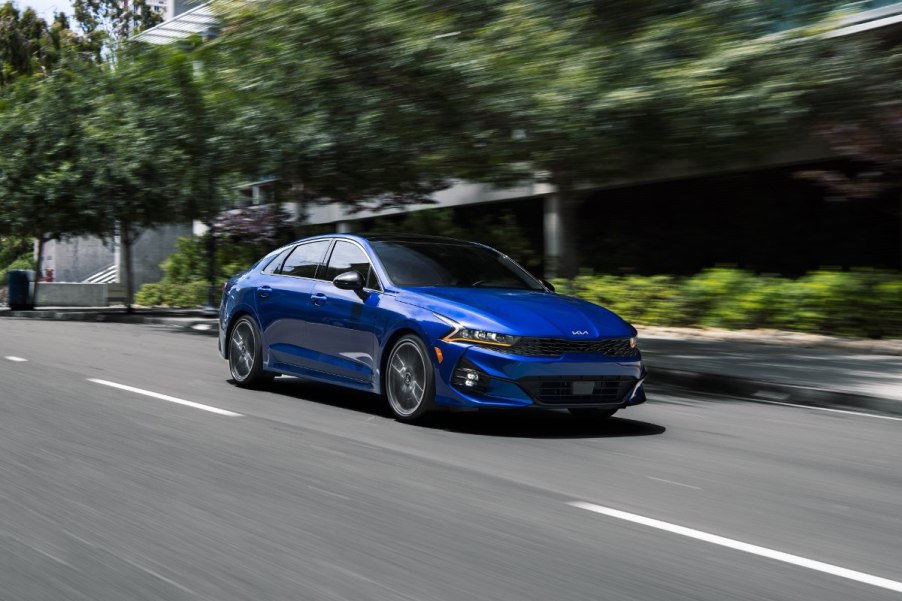
What Does K5 Stand for in the Kia K5?
The Kia K5 is a midsize sedan formerly known as the Optima. As with other cars using letters or numbers in their names, such as the Mercedes-Benz GLC, the K5’s moniker has a purpose. So, what does “K5” in the Kia K5 stand for, and does it have any significance to the brand?
A brief history of this midsize sedan

The Kia K5, previously known as the Kia Optima, has been available for five generations. The first came in 2001 and was based on the Hyundai Sonata after Kia and Hyundai’s merger. At the time, it was the brand’s most expensive model and came in LX and EX trims.
Both had 2.5-liter engines producing 149 hp, although buyers could opt for a 170-hp 2.5-liter V6 instead. Kia later upgraded the V6 to produce 176 hp. Also, transmissions included an optional four-speed automatic or a five-speed manual.
The second generation was available from 2007 to 2010 with the same two trims. However, the available 2.4-liter four-cylinder and 2.7-liter V6 engines boasted increased power at 161 hp and 185 hp, respectively. As for the five-speed manual, it remained, though a five-speed alternative replaced the four-speed automatic. In addition, Kia redesigned the body and interior.
According to Autolist, the third-generation Kia Optima arrived in 2011 with 200-hp four-cylinder engines for the LX and EX trims. They could be paired with a six-speed automatic or a six-speed manual. However, two more trims debuted: the EX-Turbo and the SX, packing a 274-hp turbocharged four-cylinder.
There was also the Kia Optima Hybrid, whose engine and motor made 206 hp. Later in the generation, Kia discontinued the EX-Turbo, and the Optima Hybrid split into LX and EX trims. Furthermore, an SXL trim debuted with most of the previously optional features.
For the fourth generation, the only change to the hybrid model was the addition of a plug-in hybrid with a 2.0-liter engine and an electric motor. The 9.8-kWh battery in this model could power the car for 27 miles.
As for the non-hybrid LX, EX, SX, and SXL, they came with a 185-hp 2.4-liter four-cylinder or a 178-hp 1.6-liter turbo-four. The former paired with a six-speed, while its counterpart came with a seven-speed, both automatic.
Currently, this midsize sedan is in its fifth generation. Kia introduced it with the 2021 model, boasting a facelift and a name change from “Optima” to “K5.” The South Korean automaker also cut the hybrid variants from the lineup.
What does ‘K5’ stand for in the Kia K5?
Kia hasn’t defined the meaning of “K5” in the Kia K5’s name, so it’s likely an alphanumeric moniker to differentiate this model from others in the manufacturer’s lineup. (However, the “K” in “K5” seemingly nods to the first initial in the company’s name.) This naming convention is similar to that of the Kia EV6 in the brand’s electric lineup, with other EV1 to EV9 models planned. (But in the EV6’s case, “EV” probably stands for “Electric Vehicle.”)
Kia sells other K models around the world. For instance, the K9 is available in South Korea and, according to Motor1, was redesigned for the 2022 model year. Previously, it was available in the United States as the Kia K900. And the Kia K4 is sold exclusively in China.
The current state of the Kia K5
Since the 2021 model year, the Kia K5 has had an aggressive-looking exterior and offered LX, EX, LXS, GT-Line, and GT trims. Most have a turbocharged 1.6-liter four-cylinder engine producing 180 hp and 195 lb-ft of torque, paired with an eight-speed automatic transmission.
However, the top-of-the-line GT packs a more powerful turbocharged 2.5-liter engine harnessing 290 hp and 311 lb-ft of torque, with an eight-speed dual-clutch transmission. The extra power and torque propel this performance model from 0 to 60 mph in 5.7 seconds.
Also, the GT-Line trim comes exclusively with AWD, per Kia.
Tech features like Apple CarPlay and Android Auto are standard, as is lane-keep assist. But other advanced driver-assistance systems, like blind-spot detection and adaptive cruise control, require an upgrade. Also, infotainment systems include an 8.0-inch or 10.25-inch screen, depending on the trim.
It’s worth noting that during its stint as the Optima, this midsize sedan was also known as the Magentis and Lotze in specific markets outside the United States.


